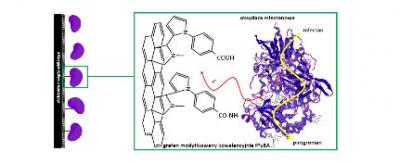Researchers at the Department of Chemistry of the University of Warsaw in Poland have developed a new graphene matrix, as a functional substrate for immobilizing enzymes, and the method of its preparation. The newly-patented graphene matrix may find applications in the food and medicine industries, like the production of biosensors and other electronic devices (eg. bands, tattoos).
 Diagram of a lactate biosensor composed of a graphene matrix and a lactate oxidase enzyme, deposited on a carbon electrode
Diagram of a lactate biosensor composed of a graphene matrix and a lactate oxidase enzyme, deposited on a carbon electrode
The invention is used as a stable system with high sensitivity, not only in analytical biosensors, but also in bio-fuel cells used in medicine, biology and chemical biocatalysis. The solution concerns the enzymatic (protein) sensor construction for detection of lactates, which can be used in the food industry and medicine for the production of biosensors.
The new method of graphene modification and proper arrangement and selection of layer components significantly affect their bioelectrocatalytic reactivity to the substance (lactate) being determined, and as a result gives a stable system with very high sensitivity.
This project is supported by The University Technology Transfer Centre (UTTC UW), which is also looking for partners to commercialize and spin off the technology. A patent application and PCT phase are currently in progress, with models of biosensor to confirm it works.

